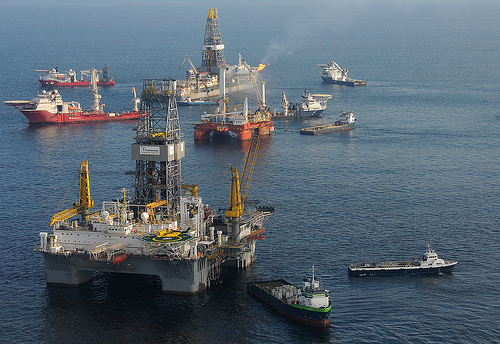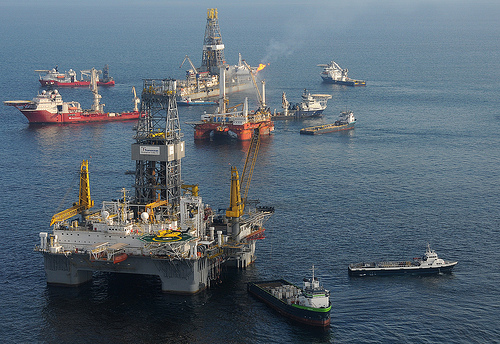 A mobile offshore drilling unit (front) drills a relief well in case this week’s top kill/junk shot attempt fails.U.S. Coast GuardBP’s latest one-two punch–pumping “heavy drilling fluid” with a junk-shot chaser–seems to be slowing the leaking Gulf oil well. But don’t uncross those fingers yet.
A mobile offshore drilling unit (front) drills a relief well in case this week’s top kill/junk shot attempt fails.U.S. Coast GuardBP’s latest one-two punch–pumping “heavy drilling fluid” with a junk-shot chaser–seems to be slowing the leaking Gulf oil well. But don’t uncross those fingers yet.
“It’s going pretty well, according to plan,” BP chief Tony Hayward told ABC television Friday morning. “We will go back to pumping mud later in the day.” But, Hayward added, “It’s probably at least 48 hours before we could have confidence that we succeeded.” BP has spent $930 million on its furious but not terribly effective response, and watched its market value plummet by billions (sniffle).
At the White House, President Obama on Thursday called a halt to new offshore drilling leases, suspended 33 active wells, did some clean-energy stumping and took the unusual step of, well, taking responsibility for oversight failures. “In case you were wondering who’s responsible, I take responsibility,” he told reporters in a spill-focused press conference (wrap-up here). “My job is to get this fixed.”
Obama heads to the Gulf today, his second trip to the scene of the crime since this whole fiasco began on April 20.
Even if BP’s top kill/junk shot maneuver succeeds in finally capping the leak, millions of gallons of crude are already sloshing around the Gulf. Best guesstimates put the total amount of leaked oil at between 18.6 million gallons and 29.5 million gallons-loads more than the 11 million gallons of crude spilled from the Exxon Valdez. (Can you say “environmental catastrophe?”)
And cleanup workers have been falling sick at sea, possibly from hazardous fumes and materials. Several have been airlifted to hospitals. Workers and relatives blamed chemical dispersants, and an emergency room doctor said the symptoms – which include weakness, rashes and coughs – were typical of chemical exposure.



